I don't know if anyone still has this blog bookmarked. Probably not too many of you as I haven't updated it in three years. If you want to keep up with the things I am keeping up with, for a little while I moved on to wordpress at Kidontology.wordpress.com, and these days I have a much quicker, frequently updated blog over at http://yanatone.tumblr.com/ Thanks and stay classy!
Stronger Loving World
A Cultural Criticism WeblogE-Mail Murdervision
Friday, March 25, 2011
Friday, February 22, 2008
I saw Persepolis at the Mayan Theatre in Denver (marquee reads: "bar open/see movies in double vision") Persepolis may not be the best movie to come out last year, but it might be the most important. It's also the most versatile, able to portray a range of emotional spaces while never de-emphasizing its animated body. Persepolis successfully acts as a docudrama on 1980's Iran, as well as a gut-walloping personal memoir. Yet it remains in its every moment a cartoon--weightless, melodic, amorphous, hovering above seriousness as it discusses war, death, and revolution. This is what I like the most about Persepolis- it relies on time tested tropes from the rich history of animation in order to tell an important story that may have been bleak, pretentious and humorless otherwise. Persepolis makes light of war, revolution, and fascism in its worthy bid to supply it victims dignity.

If you've read Marjane Satrapi's comic, it's still worth seeing the movie to witness how every quirky panel, joke, and clever aside ebbs within the movie with a perfect comic rhythm. In the introductory scenes, the doe-eye avatar of young Marjie, who at five years old is an avowed Bruce Lee fan, creeps with faux-karate steps toward another girl, face comically earnest, proclaiming "revenge is a dish best served cold". When her father threatens discipline, little Marjie creeps in reverse, unwavering in her movie hero gait and deadly serious expression, but clearly acknowledging a fear of being reprimanded. It's a perfectly tuned introduction that's cute and funny and well timed as any old Warner Brothers cartoon. Marjie's unusual romanticization of Western culture is pointedly demonstrated: ABBA and Micheal Jackson infiltrate her restrictive life through dealers who whisper the names of their wares to Marjie as if they were dirty street names for narcotics. Adolescent Marjie adopts a leather jacket with the hand-stitched words "Punk is not Ded" and wears Adidas sneakers which, ironically, leads to her getting into trouble for being "a punk" by the non-english reading locals, simply because Adidas is a recognized Western brand. At one point, a rebellious Marjie brings home an Iron Maiden record, the tiny cultural relic galvanizing thirteen year old Marjie to played pump her fist in the air and plays air guitar in her room.
Persepolis is cute, but it's pretty fucking poignant too. In a pivotal scene that nearly brought a brother to tears, Marjie's mother, exhausted and terrified by her life-threatening and subversive outbursts in class, frantically explains how one of her friends was "married" by a guard to facilitate her rape. Not pausing between words, she then falls to her knees and squeezes her daughter, assuring that she won't let anything happen to her.
This leads to the marginally less interesting second act of Persepolis, in which Marjie studies in a boarding school in France, befriending Austrian nihilists and having clumsy love affairs. Fortunately, Persepolis is strong enough to hold its own as personal memoir as it does first person political treatise, and when Ms. Satrapi returns to a war-torn Iran, she is a more empathetic, focused guide.

Persepolis is primarily two-dimensional, cel-shaded animation, which I found to be generous after watching Pixar's Cars seventeen times with my nephew. It also utilizes rotoscoping and flash animations for interstitial scenes, all of which allow the movie a cool, flexible look that never comprimises its overall flavor. The soundtrack is lush and orchestral, filling up every bit of emotional space and, at times, becoming a little overbearing. This is an inevitable necessity of animated films-- they need music to micromanage every breath and fingertap. I think of it as a big old skeleton made of piano keys.
So there you have it, this is my favorite movie of 2007--I liked it even better than the popular Daniel Day Lewis Talks Loud Movie and No Country For Zero Sum Games. Also, it contains what I promise is greatest montage of "Eye of the Tiger" ever set to film.
Sunday, November 26, 2006
DAT Politics performed last night at Tonic, along with Kevin Blechdom. DAT Politics are electronic musicians from Lille, France. Kevin Blechdom is Kristin Erickson, an Oakland native (and Mills College alumni) who is most famous for being one half of the band "Blechdom from Blectum" with her then girlfriend (who took the stagename Blevin Blechtom). When the duo split a few years back, each retained their stagenames.
The opening act Lumberrob, was a human beatbox act, wherein Rob used a pedal to cue pre-recorded beatboxing tracks and played with them live. This provoked a few really nice moments, as when the multiple layers cued out, Rob did something weird, and upon stomping on the pedal 4 or so tracks rolled back in. I guess it was sort of a joke act, though.
Also performing that night was Ching Chong Song, a really weird guy/girl duo, the guy on piano ("and wearing a piano tie") and the girl performing operatically. Similarly to Kevin Blechdom, she sang funny, silly songs but does it with faux-earnestness (or earnestness?). Kevin also played along with Ching Chong on banjo for a song or two.
I was really excited to see Kevin Blechdom, because I've read crazy things about her live shows. Touring for "Eat Your Heart Out", Blechdom played topless and covered with goats intestines. That wasn't the case this time, but it was pretty raunchy. When she entered the building she was wearing a coonskin cap and a suede jacket. When she went up for her set, she had changed into a white gown, and, as we later learn, nothing underneath. Her set offered very little other than her trademark handwaving and pantomiming, along with some jokes. At one point, for instance, she said "this is the best song I've ever written", and then pantomimed a 3 or 4 minute song without singing a word. She played up how dramatic the song would be if you could only hear her voice but kneeling on the floor, stabbing the heavens, rolling around, pointing, etc.
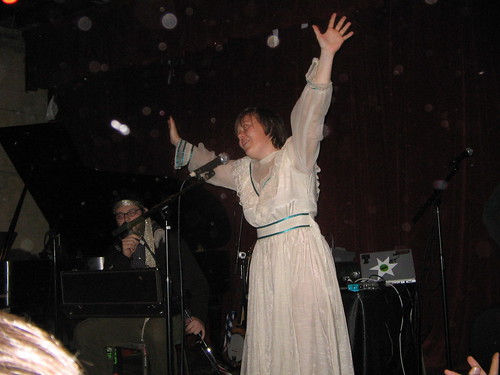
At some point during her set, Kevin proclaimed that she was going to commence the first ever "masturbation olympics", at which point Julie from Ching Chong Song came onstage and they both lifted their dresses and showed their bushes to the audience. The piano player played and they both masturbated in front of the audience (Blechdom humping the floor at one point) until Kevin said that she "won". When the piano player asked if she had orgasmed she said "uh I think so", clearly wanting to finish up the bit, which obviously had no coherent ending. The piano player teased her about this by saying "you think so? Have you never had an orgasm before?"
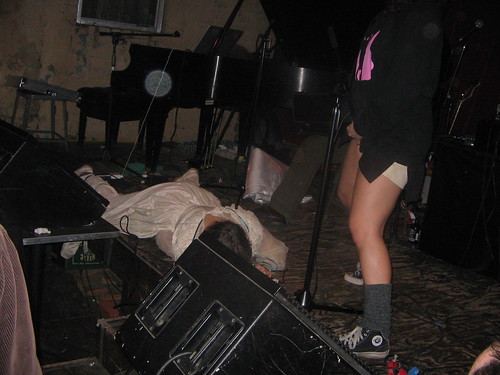
And then Kevin excitedly said that Julie would do some "forced queefs" into the microphone for us. Which she did two of.
I was pretty sure that this broke some kind of public indecency laws, but according to New York State statute 245.01:
"New York
245.01
(Exposure of a person)
Appearance in a public place with private or intimate parts unclothed or exposed. "For purposes of this section, the private or intimate parts of a female person shall include that portion of the breast which is below the top of the areola. This section shall not apply to the breastfeeding of infants or to any person entertaining or performing in a play, exhibition, show or entertainment."
Speaking to Kevin afterwards she said she was "really drunk" and didn't think she performed very well. The set was definately sloppy and hindered on her being fearless and obnoxious. Blechdom's recorded music, particularly Eat Your Heart Out is great because it uses cabaret, performance, and irony as conduits to demonstrate very simple, earnest ideas. Blechdom understands that sometimes you can't sound earnest without using irony to communicate. After the masturbation olympics and the queefing, she sang "Slow Me Down", which is the softest, most straightforward, and gentle song on the new album.
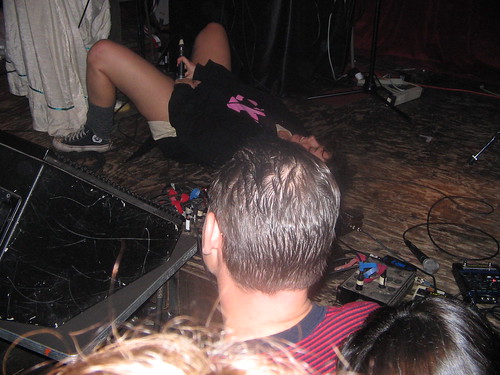
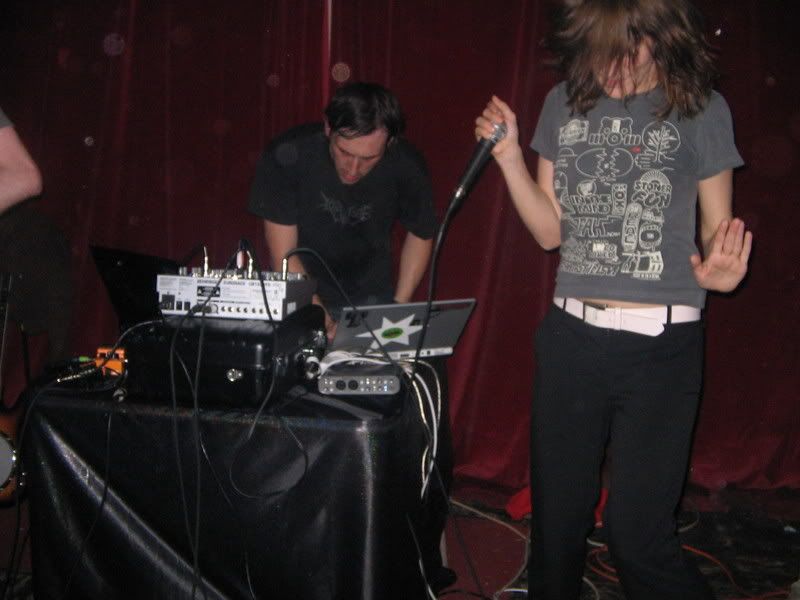
Almost all of the songs they performed were from Wow Twist. Wow Twist is very upbeat, very palatable, and very much designed for live performance. The set plowed through all of the songs, with Gaetan hopping up and down and swinging, her tiny frame flopping as if she was in a punk band. Very little else was added to the show, except that all of the tracks were "weirded up" and drawn out for live performance. "What's DAT", was pulled out into a dreamy, twinkling, repeating beat as Gaetan screamed "What the fuck is DAT? What the fuck is DAT?" (which does not happen on record) The last two songs were "Turn my Brain off" and "Gravity", the latter being the encore, which are also the poppiest of the songs on the new album.
The last time I saw DAT play was at Tonic in May 2003 and this set was very different. At that time, touring for the just released (and amazing) Plugs Plus, they were playful but ultimately sort of conceptual and out there. At one point they used virtual drumsticks to play along live with the audience. I think there was still an understandable novelty to being a "laptop musician" at the time, at musicians like Terre Thaemlitz and Max Tundra were trying to find weird elements to add on to the set make them more interactive.
This time, only one of the band members had a laptop onstage, with Gaetan bouncing around with a microphone, unencumbered by machinery. The emphasis was on getting people to dance, which they did very successfully.
That's the other thing, when I saw them in 2003 there was definately next to no dancing. Indeed, I don't think Tonic was perceived as the type of place where people danced. I was really surprised to see all the bopping heads at this show, although I'm not sure if it's just that DAT politics has loosened up or if new york has.
Also, I bought an EP of new DAT material that was just released by ski-pp, although I haven't heard it yet.
Also, I spotted Nathan Michel in the audience and told him how much I like the Beast. He recognized my name from an e-mail interview I did with him 3 years ago and said, "that's the best interview I've ever done!", which was flattering, but I think I scared him away due to the fact that I was very, very drunk and tired and probably gushing.
Also, I did not get home until 5 in the morning. This has been happening to me lately.
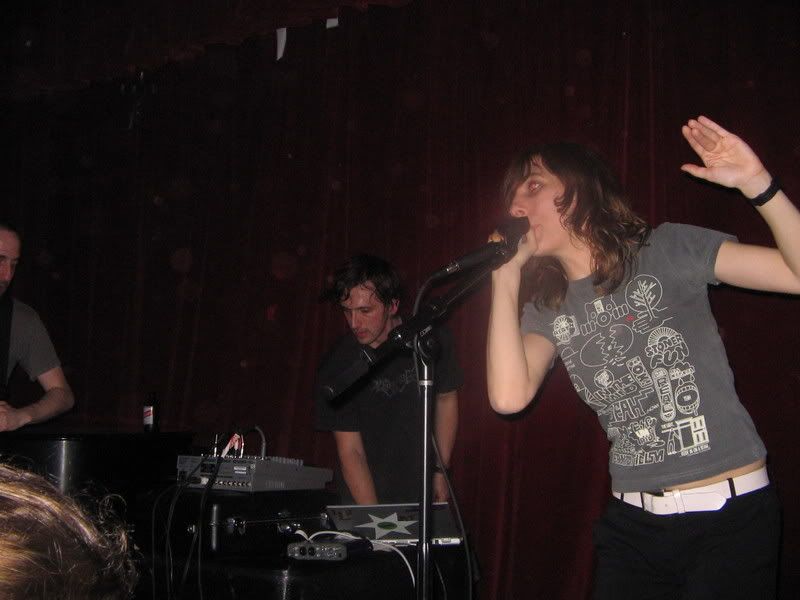

Here is video of DAT Politics performing in SF to give you an idea of what they are like live:
the end
Wednesday, October 04, 2006
Tristan Eaton, the Brooklyn based street artist and toy designer, was instrumental in the formation of Kid Robot, which now has stores in L.A., New York, and San Francisco, and remains at the center of designer toy culture. Looking at Eaton’s work, it’s no wonder that he is responsible for the soft, sleak, and hip cartoon monsters that make up Kid Robot’s product line: his gallery and street art carries the otherworldly glow of old-timey picture shows, WWII era Warner Bros. cartoons, and is infused with the toxic effervescence and renegade aura of condensed urban spaces.

Having grown up in Detroit, London, L.A., and NY, Eaton’s eye has cut and pasted the most vivid and colorful images and textures of these spaces into a post-urban city, composed purely of ideas, that can be accessed by anyone with an internet connection.
*Your current gallery show at the Lele Gallery in Japan is titled
"Lifestyles of the Cute and Dangerous". Many artists take "cute"
images and deform them or make them perverse, but your images retain their silliness and naivete while remaining intelligent and using bright, ostentatious color schemes. What kind of an aesthetic were you trying to create, and why?
You make it sound so fancy!
My goal was to show the secret lives of cartoon characters. Cartoon
characters get in trouble too, fall in love, fight, drink and vomit just
like us. It's just the well behaved, pansie ones that make it onto T.V. and
the movies...the rest are around the corner drinking or stealing your car.
That's the world I wanted to portray. To do this i created a new series of
characters just for the show called RUNTS! They are the cute little guys
portrayed on the postcard.
I originally wanted to execute this concept by painting fake animation
cells. I used to do this years ago and loved the effect of it. But in the
process of making the work, my interest shifted a little and I just followed
my instincts. The idea of animation cells shifted to painting the characters
on layered glass (front and back) with prints behind them. This then shifted
further into doing work with gold leaf on glass and multi-layered, glass
shadow boxes.
At the end, the show became way more Pop and Abstract than the more
narrative approach I started with. I loved that. The whole show ended up
having a great variety of work. 40 pieces in total, ranging from paint on
glass & gold leaf to printed posters and hand painted skateboards. I also
created a 4" tall, cold cast marble figure exclusive to the exhibition.
Limited to 5 pieces world wide.
It was an amazing honor showing in Japan and probably one of the greatest experiences of my life.
*What's your role in the formation of Kid Robot and vinyl toy culture?

Well, when Kidrobot was a small website Paul asked me to come on for a number of things. I designed the logo and a lot of the initial packaging, branding etc. along with FILTH. I then began managing the initial wave of toy production which entailed designing the DUNNY figure, KIDROBOT figure, SKUMBO, TORO, Cheech Wizard and The Brooklyn Qees. At the same time I was curating artists and developing fun, future toy projects.
My role in Vinyl culture...I feel like I'm just hitting my stride now. By forming THUNDERDOG, I've been able to make really interesting toys that can take risks and push the boundaries of what we're doing. I'd like to help people recognize the artistic merit of the toys in this field. Some of these toys are worthy examples of contemporary fine art and I'd love to help bring that to the light.
Why do you think this niche market arose when it did, and what will
be its long term impact on culture?
http://www.demo-design.com/v5/img/vk1.jpg
There's a huge fascination with limited edition culture in general right now. From sneakers to clothing and back to toys, people do not want a mass produced & mass marketed product. When you have a product that's limited to 100 pcs you feel part of an exclusive club and also closer to the culture that it came from. I understand this concept well, although I'm not sure exactly why it happened now of all times...
Long term, I think this movement will probably expose a few amazing artists who might not of otherwise had a platform or audience as well as heightening people's expectations for what a toy can be. The boundaries are being pushed so far that toys will never be the same again. I also admire the fact that buying art toys can be a very good introduction to buying actual art. Many toy collectors have made their first jump into buying their favorite artists’ paintings and it seems that buying art is becoming more accessible and fun for people. That is really cool.
PS: You work in street art, designer toys, and create gallery art. What do you find rewarding about each of these mediums, and is there one to which you identify more?
Honestly, I identify equally with all of them. It's all the same to me, just
a switch of context. I think it would be impossible for me to
stick with only one medium or method. I would go crazy.
Making toys can be very rewarding though, because of the production time. By the time they arrive it's like 'FINALLY!' and you jump up and down while foaming at the mouth. Good times.
PS:*Is this a lifelong passion for you?
It was never in question. Growing up, I was always 'the new kid' having been through 16 different schools, and luckily I found comfort in being a little different and being creative.
PS: Are there any people in particular who helped you out?
Well, I've always felt like a loner from moving so much, but when I lived in Detroit I started to feel pretty accepted by all the artists at CPOP Gallery. Rick Manore the owner introduced me to artists like Glenn Barr, Mark Dancey and Tom Thewes...all of which inspired me in a big way. Also, at the beginning of KidRobot, we started to reach out to artists all over the world. At this point I started to meet a lot of people like me, whose work I really respected. At this point, I started to feel like I was a part of a global community of artists who shared a similar vision.
PS: You grew up in London, Detroit, and L.A. Can you take us through how each of these spaces impressed themselves on you, and how they each shaped your art? What people or places in these cities influenced you the most?
Wow, big question.
L.A.: My first art teacher Ed Warren, The slimy glamour of Hollywood neon, The Mans Chinese theatre, Skate and Surf Culture in general, (especially The Bones Brigade and all of Powell Peralta, T&C, Maui and Sons etc.) design and culture in the early eighties. My uncle Rabindra Danks' beautiful art, L.A. Arcades!, Seeing Haley's Comet at the Griffith's Park Observatory, All of my parents eccentric and creative friends, MAD Magazine, And of course, my baby sitters when I was 6 years old: Ione Skye and Phoebe Cates (wow).
LONDON: London Graff: MODE 2, ELK, REM, ASIA, TMD, IMASE, Dr. Mat Eaton aka ASK, 2000AD Magazine, Illustrator Stuart Harrison.
Seeing Akira for the first time in a small Picadilly theatre, The show 'Spitting Image', Games Workshop, First seeing Roy Lichtenstein's work at the Tate Modern, All UK television: The Young Ones, Black Adder, Doctor Who, Red Dwarf, Every thing Terry Gilliam, The London Underground.
DETROIT: Cpop Gallery & Rick Manore, The beauty of a decaying city, Glenn Barr & Mark Dancey, Scaling abandoned buildings,Photographer Lisa Spindler, Artist Robert Mcgee, Belle Isle & Jefferson Avenue, Detroit Ghetto Tech.
The Heidelberg Project & Tyree Guyton, The ghosts of Cass Corridor, Sculptor Ed Sykes, My teacher Lester Johnson.
And a million other moments, people and objects that I was lucky enough to find but too lazy to mention.
PS:Like D*Face or the London Police, you have a tendency to create characters that are cartoony, cute and otherworldy. Your work, however, captures the essence of Golden age animation-- How do you see the relationship between the more vivid and classic looking characters in your street art and the cities you place them in?
I try to make my work as classic as possible. it seems as though that era's quality of character design has prevailed throughout many generations. Maybe because it's reminiscent of better times or maybe the style is just powerful and lasting in some way. I personally love drawing that style...it feels comfortable and makes me smile. I like street art that improves its surroundings. By beautifying a street or just creating a smile on someone's face, the art is doing a valuable service! I hope that my art can do the same thing. I also like the idea of a million little characters let loose in a city. Like Toon Town's gates just opened and the Toons are running wild in the city painting, pooping, having sex and what not! That way it makes sense to see them half way up a fire escape or down an alley somewhere...
PS:How do you feel about "branding" in street art, then? (Linking an identity, logo or character to a specific artist, so that the image
can be cross-marketed later) Do you ever find yourself doing this, as you work in several different mediums?
I don't like it when something is branded in street art specifically to be marketed afterwards. I think that cheapens the street art into being a marketing tool. I find my self using my characters in all of my art in all mediums because I enjoy the freedom. That's what makes street art special. You can do whatever you want (or whatever you can get away with) and there will be an audience there for it.
*How have websites like Wooster Collective effected you and the street art scene in general? Do you feel like there is a stronger sense of community, and how has it changed street art aesthetically? Has the "globalness" of street art been a hindrance to you in any way?
I think Wooster is great. Websites like that definitely help build community as well as awareness among artists and spectators alike. I love going on there and seeing what Calma just did in Brazil, or what Kid Acne just did in London. It's fantastic.
*I sometimes think that the battle that artists face is the war
against boring shit. What has been boring your eyes lately, and what have you been doing about it?

Ha ha. I agree. A friend of mine owns a great shirt that simply says ' A lot of art is boring'. And it's so true. I have to steal that shirt.
Lately, a lot of the more commercial toys that are being aimed at and promoted in the world of designer toys are boring me. A lot of the same type of design and same concepts are being done over and over. Platform toys in-particular. It's getting dead.
In response, we just go further, weirder and more underground than anyone can go to set ourselves apart. We've chosen not to participate in any of the big toy conventions because it seems too commercial, predictable and limiting. Instead we've been exhibiting our toys in galleries with the hopes of being more 'artsy fartsy'. So far, we've become very 'artsy fartsy' and it's working out great.
Sunday, February 26, 2006
Forever Woman
I watched La Passion De Jeanne d'Arc" Thursday night, at Artist's Television Access in the Mission District. (Artists's Television Access is a wonderful resource that I highly reccomend; it's conveniently accessible on Valencia and 21st, and the interior design is visually charged with the same toxic glow that much of the Mission District communicates. The theatre is very small, with a capacity of maybe 25. There were only 12 people in the theatre attending the film.)
The Passion of Joan of Arc (1928) is a silent film, directed by Carl Theodor Dreyer, a Danish filmmaker who only made a handful of films. This was his first feature film, and this original master cut was lost for over fifty years (presumed lost by the director himself) before being discovered in a janitor's closet in a mental institution in Oslo in 1981. (A version of the film is watched by a character in Godard's Vivre sa Vie (1962), but I guess this is the bastardized, edited version.)

The film was originally released as a silent, although the version that was circulated for years included a soundtrack. The version I saw had live accompaniment: an amazing new score by one Lester Raww, an electronic/improvisational guitar guy who's been in bands called Pine Box Boys and The Zag Men.
The core of the film is the actress Maria Falconetti's performance. As the story goes, Dreyer had the script for his meticulously realistic portrayal of the trial and execution of Joan of Arc ready when he spotted Falconetti performing a small play and instantly decided she was "the one" for the roll, because her face communicated an unending depth and heartbreak. "There is a soul behind the face", he said, or something like that. This was her first and only feature film; aparently Dreyer's draining, emotionally intense direction drove her away from the cinema for life. Supposedly, he made her kneel on stone slabs for hours on an end to get the perfect emotional state.
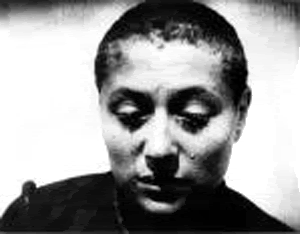
I was interested in watching this film because I read it described as an intense psychological character study focusing on a female face--which it was. All of the shots are intense and claustrophobic, the frame focusing on Joan and her inquisitors from the neck up, the details on their faces rich, textured, and sculpted; the talking heads appearing crepuscular, dense, and chiseled, like emasculate granite slabs showering bible verses at one another, as Raww's soundtrack narrated the intensities of their dialogue and the subtle, slow, powerful leans that their faces made as they lurched from one emotional state to the next. These transitions were some of my favorite parts of the experience and what I felt the new soundtrack did best--it used a post-industrial lexicon to articulate and accentuate emotional "distortion", interpersonal "white noise" and radically violent dark age emotions. It wasn't quite "anachronism" because that term suggests a discconent between supposedly disparate time periods, whereas Raww's post-electronic crackles vibrantly reclaimed the industrial/modernist lense of Dreyer, who himself was (albeit in an attempt to literalize rather than emphasize Joan's story) crunching, decompressing and intensifying a 15th century trial in which no cameras were present. What resulted is more like synchronism, a piece of music being "before its time" and finding its audience too late, an evolutionary trait perfected millenia ago but designed for a plague coming next century, a composition frustratedly designed for an instrument that had yet to be invented. Was it Beethoven who said "I am electrical by nature"? I'm also reminded of the 90's soundtrack to Fritz Lang's Metropolis whose vibrant, acid house intensity made the film as frightening, imposing, and apocalyptic as it was meant to be.
The film, like a much worse 2004 film with a similar name, focuses on Joan's trial, which is assembled from the transcript of actual 15th Century court documents. The clothing was carefully reconstructed, and the sets as well, despite the fact that the painstaking work and funding Dreyer went through were more an act of formal determination, as the film barely has any visible backgrounds or shots that peak below the neckline. The dialogue and the facial expressions take up most of the screentime, and the film lurches operatically between Joan's emotional states. The most frequently visible of these is a vacated, glassy, painful post-heartbreak, one that communicates a strength and love whose Athenic power is still barely enough to hold the architecture of the face in place. Falconetti portrays Joan as a woman who has crumbled emotionally and physically beyond any real human level, but feels such an intense sense of responsibility and knows that she literally can't crumble--she is the child of God; a martyr for France, the most important woman in her country and someone who has been entrusted with a love and a duty beyond understanding. Yet she can't help but break into paroxysms of emotive, personal hurt when she is harassed, taunted, and tortured by her captors--she knows that this is the way it is and why, but her empathy and horror at the turn the revolution has taken is condensed into an interpersonal angst, looks that say "you treat people like this? You treat human beings like this?", let alone, you treat me like this?. What else is there to say about Falconetti's face? The richness of the shots are designed to amplify the nuances of her face, but especially her recognizability: I have met this woman before, I've been looked at in this way before, I've seen the hope drain from a woman's eyes this way before, I have kissed this woman before, but this time I am watching die, being filled with holes, pricked with needles and burning because she believed in something stronger and braver and bigger than I ever did.
The turning point of the film comes after Falconetti has repented and recanted and has been sentenced to life imprisonment; out of seemingly nowhere, what we can only assume is the spirit of god fills her and her eyes light up with a certainty, an absolute understanding that transcends her emotional state. She asks for the inquisitors to return: she lied, everything she said was a lie, and now she wants to tell the truth. Her inquisitors by this point have developed a sympathy for her and assuage her from confessing the best they can, but Joan's decision is final, and she is warmly talked to like a prisoner on death row saying their final prayers. This is where Raww's soundtrack succeeds the most: as Joan comes to her epiphany the music becomes intense, prickly and builds towards a crescendo with hopeful undertones, a moment that stretches out as Joan is lead to her death, and as the pyre is lit, and Joan's face glows, eyes heavenwards, affixed on a dangling crucifix that falls conveniently in her eyesight, the intensities drop out and flatten in infinite plateau; an ambience void of any lost intensities or striations: Joan and Jesus are married in this moment, and as the villagers and rioters tear apart the courthouse and destroy the scenery, as the camera portrays top down visuals of the anarchic, feverish, violent chaos, Joan's sillhoutte burns along with the music and along with her God, consumed, as the viewer should be, by a peace that passes understanding.

Friday, February 17, 2006
Romantic Comedies for The Painfully Alone
After a few hours at a side job in Oakland on Wednesday, I bike-BARTed, my new verb-form for the bay area, to a Casiotone for the Painfully Alone show in San Francisco. I initially decided I wasn't going to go, as trying to get around San Francisco with public transportation can be a chore sometimes. Fortunately, I realized that the Make Out Room is in the Mission District which is incredibly convenient via BART. The opening act, a four piece girl band with a dude on drums that I've never heard of, is endearing because they perform minimalist pop songs with clever harmonizing, unabashadly prom friendly lyrics and they play their electric guitars and bop their bodies around like sixteen year olds. They are all wearing ties and catholic school girl get ups. I realize that in the past few years there's been a resurgence of "the uniform" within indy-pop, and I don't really have a problem with that. So I took a moment to ask myself WHY I don't really have a problem with that.
Q: Yo Church! Why don't you have a problem with uniforms?
A: I suppose it is because, when I see a band in uniform, I immediately picture them all sitting around the basement of one of their parents, and one of them says, "you know what would be really cool? if we wore uniforms!", and then everyone goes "yeah!", and everyone starts to fidget and get excited and think to themselves, "oh man, this is really happening! we're like a real band and everything! this is so cool! I've wanted to rock out my whole life and finally, we're rocking out!" Then I picture them at band practice a month later, and one of them is not in uniform, and one of the other girls is all like, "guys, I thought we agreed that we were all going to wear the uniforms to practice!", and then, and then there's this tension and catty drama and then there's a big argument, and in tears, the fat one is all like, "guys, this band is falling apart! guys, this band used to mean something to us! guys, you guys are like a family to me!" Fortunately they all manage to reunite in time to play the big battle of the bands and they win the money to save Tom's Record Store from being bought out by DeathCorp. Then one of them professes her love for John Cusack. Or all of them. Anyway, I think it's cute.
Q: Fag!
A: Uh, uhhm.
Q: You're a fag!
Casiotone was pretty solid live, but it didn't occur to me until I got there that it's almost counterintuitive to see Owen Ashworth perform in person. The whole point of Casiotone is that the cinematic snapshots (also prom-friendly lyrics by the way) coupled with vocal distortion and minimalist synthesizer backing tells us stories that are too familiar, specific, and endearing to be anything other than bedroom recordings that our high school friend made for us to cheer us up. It's made to be playing in your car stereo or shitty boombox while you dawdle your life away on livejournal in the oblivious daze you've medicated yourself into, successfully nulling all of your previous hearty-aches and failed relationships and regrets until it emerges sullenly and slowly in the background like the end of the montage in a romantic comedy in which the protaganists have taken time apart from one another but are just begining to remember that deep down they miss each other. Only there is no reunion with meg ryan at the end of your Casiotone song: only twinkies and internet porn as far as they eye can see.
I had to leave the Make Out Room early, while Casiotone was in the middle of an insanely catchy duet which is still burning and bumping in my eardrums right now, unfortunately, because the BART ends service at 1200 AM and I had to get home for to be sleeping and such. Jee, I wonder why the BART closed so early? There must be some sort of MTA strike or something, a union dispute of some kind, or--MAYBE IT'S LIKE THAT EVERY GODDAMN DAY, BECAUSE THE PUBLIC TRANSPORTATION IN SF IS TOTALLY FUCKING RETARDED. You don't know what you got until it's gone.
I wish I could make more romantic comedy plots to detail my bikeride home--outside of the Muppet Movie I can't think of any substantial romantic scenes that take place on bicycles. Although San Francisco is one of the few places I've been where I half expect Muppets to emerge on bicycles on the streets, an image of one of Animal's bandmates with a toke in his mouth riding by an unblemished retro 80's graffiti piece on market street is blaring in a room in my mind designated "the holographic projector booth of unfulfilled desires". It is guarded by a man on stilts in a red suit and top hat who blows fire and flails his arms around quickly to distract me while he picks your pocket.
Some final thoughts: Thinking about Casiotone's music in terms of narrative, and not just ambience is part of a gradual internal shift I am making regarding the romantic comedy as medium and its wider implications for the production of meaning in culture. I've long regarded the romantic comedy as a particularly delectable brand of poison, but the worst kind of poison nonetheless; MUCH worse than movie violence because the expectations and values it represents, when reinforced and played dramatically over and over provide the sort of conditioning that makes people delusional, perpetually heartraped losers. But Casiotone's tortured symphonies, self-consciously, cartoonishly "authentic", are a celebration of idealistic, teenaged brand of self-torture that those romantic ideals produce, rewinding and replaying the moments which those admittedly lofty and juvenile ideals were crumbled. It is as if,by turning ideals into stories, we've captured the magic, disenfected the charm by analyzing it, and we are free to live our lives as heartsick and wobbly as we'd like, provided our naivete always transfers instantly into that most valuable product: narrative.
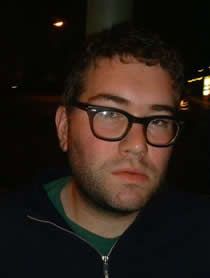
Monday, December 05, 2005
Interview: Me Otch
Interview done a few months ago with Me Otch, which has been languishing in my hard drive. Please excuse the lame introduction. I'm back in California, by the way.
When the atomic bombs were dropped on Hiroshima and Nagasaki, the sillhouettes of some of the victims had been burned into the walls and the streets, an eternal photo-imprint of the last seconds of their lives. Though they are subtle, soft imprints, their presence communicates an absence, the space where love once was, where hope melted into the air. A lot of street art reminds me of this, particularly photo-realistic ones like the surreal tableuaxs of Me_otch: ghosts that accompany us on our travels through the city. Me_Otch’s ghosts spring out in random street corners in Williamsburg, Brooklyn. They are peeping toms, loving giants from a netherworld behind the bricks and mortar, flaring out into the toxic light of Brooklyn to make sure that we’re ok,ay or maybe just to play with our heads and our increasing wartime insecurity.
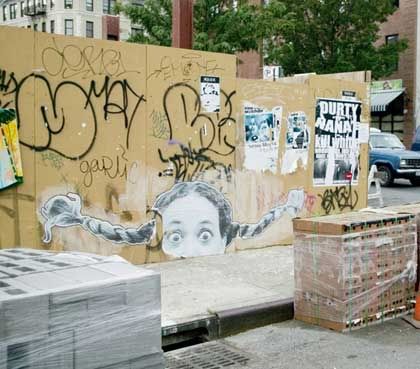
Where did you grow up, and how did it influence you artistically
Me Otch:I'm Cajun. I grew up in Lake Charles, Louisiana. It's a small town in
southwest Louisiana. Growing up there had a huge impact on me artistically.
I used to go to New Orleans all the time. Jazz, Zydeco and all sorts of
music are very important down there. I thought this was normal all over the
country when I was growing up but now I realize how lucky I am to come from
there.
It's definately a heartbreaking time to be from Louisiana. You say
it had a "huge impact" on you: is there anything specific in the
architecture or the music or the people that altered your perspective?
It may be hard to just pick one or two things, but perhaps there are
themes you've noticed in your work that originated there.
The attitude of the people down there has really had an impact on me. Most of the people there are poor as dirt and deal with tough times constantly but they are the happiest people you could ever run into. They know how to celebrate and have an uplifting outlook on life. They can also appreciate expression and art.
Why are you working in the medium you are working in? What other cross-pollenation does it have with other art you have worked with?
I went to Savannah College of Art and Design and graduated with a BFA in
photography in 2001. I've always been into photography. My mother is a
photographer and I grew up using old cameras she would get rid of.
Photography worked well for me simply because I'm not very good at drawing
and could always get what I wanted through the lense. Today with the
digital technology and printers the possibilities are endless. I love
printing these images and pasting them everywhere I can.
When did you decide to translate your photography interests into
street art? Was there anything about traditional photography that
frustrated you?
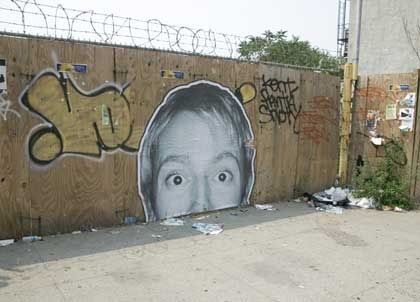
I had a friend from college move in with me and he is a graffiti painter. I used to go with him and lookout whenever I could. He really opened my eyes to the art that is on the streets of New York. I was and still am blown away. There is a freedom to it that isn't like traditional photography.
What do you see us the relationship between the characters in your art and your audience?
To tell you the truth, the worst part about street art is that you never
really know your audience. It's not like I have a gallery show anywhere
that I can get feedback from people who want to go and see the work. On the
street I don't know who wants to see it and who is forced to look at it
because they must walk by it every day. The fact that my work
rarely gets sprayed over or vandalized is positive reinforcement to me.
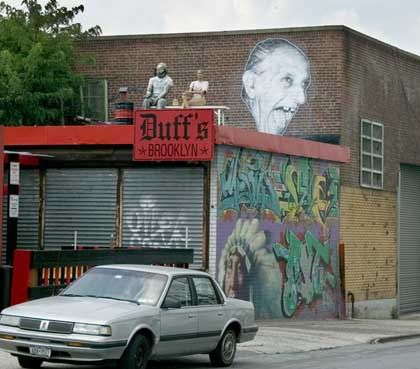
How does it make you feel, personally, when you see
photorealistic street art, yours or anyone else’s?
I love seeing the realistic values and having things larger than life. It really amplifies anything that is put in your face.

